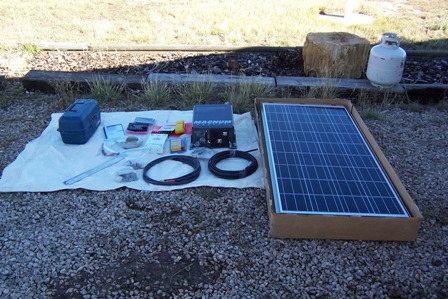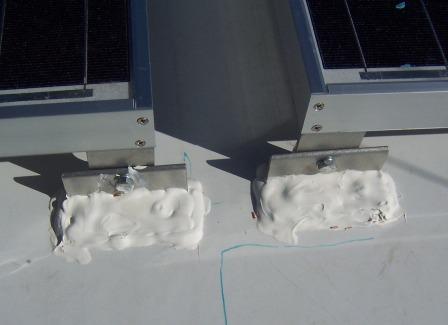A DIY RV Solar Power Installation May Not Be for The Faint of Heart!
I originally planned to have a contractor do my RV Solar Power Installation. But, since a good friend is an accomplished electrical engineer, and had been working with DC power for twenty some years, I let him talk me into US doing the RV Solar Power Installation of our System on the Eagle.
I can't say I regret the decision. But I can say, the job turned out to be just a mite more athletic an enterprise than we two old whiners had figured it to be.
Even though the weather was pretty darn nice for Wyoming in late October; 30 degrees or so in the morning, with a nice little breeze, is still 30 degrees in the morning! And that breeze makes it darn chilly at times! So we started out sort of running uphill you might say.
RV Solar Power Installation ..... sounds kind of sunny don't it? Try climbing up and down a cold almuinum ladder and crawling around in the frozen mud under a fifth wheel on a frosty Wyoming fall morning! Sweet!
Probably looked, or sounded, a little funny with the two of us stooped over and gruntin' like a couple of crusty old ogres. We kept moving, but not real fast!
I left Nunn, CO. about 8:30 p.m. and didn't stop for the night till a little over half-way. Pulled into a roadside rest area for a few hours sleep and then finished the haul, the next morning. Pulled in about 9 a.m. Tuesday morning.
We spent the next day and a half planning the job out. The estimate to have a contractor do the RV Solar Power installation had been $600 to $800. We figured we could do it cheaper while doing it a lot better to boot.
Well, counting travel expenses and the extra hardware we used I don't guess I saved much actual cash. We did how-some-ever, complete a lot stronger RV Solar Power Installation than I think I would have gotten from a contractor. At least for that quoted amount.
Counting the car I had to rent for Heidi the four days I was out of town, "Travel" expenses cost me $380. I spent $384.50 for all the extra wire, conduit, sub-panel and bits and pieces.
So, if I hadn't had to run over 1000 miles (counting all the running around while up there) and rent the car, I guess the improved RV Solar Power Installation we did ~would~ have been done at a significant savings! Cool!
The Noels Package from RV Solar Electric cost $2963 at the time I bought it. Those things change quite a bit I believe because the Solar Panel prices change real often from what I hear. But that gives you an idea of where things are as of October 2006!
The solar panels were
around $615 each ($310 now in 2013, 6+ years later) so I have another $2,460 in panels yet to install. But
when that has been done, I'll have a max capacity of 780 watts of
electrical production! (still haven't been able to catch up enough to put the additional panels on... but have been living full time, very well, for three+ years on those intitial Two Panels)
That should keep even a windy ol' cowboy story teller like me pounding the keyboard don't you think!
Back to the RV Solar Power Installation!
We layed out most of the parts to see what we would need to go get.

The main parts for this RV Solar Power Installation
- Supplied by RV Solar Electric in Scottsdale, Arizona
********************************************
- (2)Kyocera KC-130 Panels
- Xantrex C-60 Regulator
- C-35/40/60 Remote/Digital Display
- Magnum ME-2012 Inverter
- Magnum Inverter Remote
- (2)5' 2/0 cables
- 40' 10 gauge wire
- Digital Multi-meter
Where the RV Solar Power Installation contractors typically just run UV
wire, Mike and I ran everything through flexible conduit. I wanted as
bullet proof an installation as we could build. Some people are
satisfied with just running some decent UV wire.
I wanted better protection, from any unexpected difficulties, than that. In my case the unexpected difficulties are the normal every day way! Like the sayin' goes; If it 'twernt for bad luck I'd have no luck at all!
I'm a lot better off if I leave no openings for imaginative gremlins!
I wanted a system that was done right from the get go, with no problems down the road 'cause I cheaped out on the deal.
We
upsized the wire and all appropriate hardware to handle the full
planned number of Photovoltaic panels. While I only put two Kyocera 130
watt panels on with this RV Solar Power Installation, it's my intention
to put a total of six. The others will be added as soon as selling the
house frees up some more dinero! At over $600 a panel, postponing 4
panels saves me quite a bit, for a while! (those panels are now 5 watts larger and down to $310 bucks in later winter 2013)
While the two panels only call for 10 gauge UV wire, we ran #6 stranded wire down from the roof. That'll handle any possible amperage produced by the complete 6 panel Solar Array. We did however do the interconnection, between panels, with the #10 wire.
Along with upsizing the wire I upgraded the Xantrex Charge Regulator to a 60 amp model when I ordered the "kit" for my RV Solar Power Installation.
The two current panels only require a 30 amp version, but since I am going to be adding the additional Kyocera 130 watt panels very soon, it only made sense to set up the hardware for that now. Save the heartburn and expense of having to go back and redo previous work.
All I'll need do is wire in the new panels and badda boom! Triple the amps! Sweet! Take that you robber oil barons!
The RV Solar Power Installation system came as a pretty complete kit, from RV Solar Electric, down in Arizona. Checked the prices against the competition and I do believe I got about as good a deal as you can find. That coupled with their reputation for integrity and knowledge sent me straight to their door.
The only thing I had to add to complete the RV Solar Power Installation was the upsized wire we decided to go with, the conduit and it's hangers.
Oh yeah, and the two space, four circuit, sub panel we put in. That's for the three AC circuits from the main, factory, breaker panel that will be powered by the Inverter.
The Inverter provided by RV Solar Electric in their NOELS Package system is the 2000 watt inverter from Magnum Energy. RV Solar Electric recently changed to this company because of it's U.S. built quality. The old company, they used to purchase their inverters from, recently moved its production to China. It's RV Solar Electric's feeling that the quality went south. I guess that slave labor ain't all it's cracked up to be!
So, they figured to go with quality over price. I did the same figuring in this case.
Now, the Battery Bank, the 2000 watt Inverter, the Charge Regulator and the new Sub-panel were all to be located in the forward compartment,at the front of the rig. The factory breaker panel is located in the tail end. 'bout as far apart as it could get on this rig!
So we had to
run 1" flex conduit from that breaker panel, down through the floor...

...up the frame rail and across under the belly of the rig and back up through the floor into the "power compartment"...

...to the sub panel box we had installed... Piece of cake right?

Have you ever tried to poke stranded copper wire through cold, twisty, flexible conduit? Without a "fish tape"? 'cuz you don't have one and you're too cheap to buy one for "just this one job!"?
Neighbors were stopping by to see if anyone was hurt. They said the squallin' coming from Mikes place sounded like someone was slaughterin' pigs!
Took some doin' but we did finally get all those wires pulled through the conduit.

EDIT UPDATE; In the picture above of the RV Solar power installation... you can see how close the panels are positioned on the roof...oops... THAT was a MISTAKE on my part...
I'd been thinking I'd be putting more panels on ASAP... which didn't happen...
Tilting your panels in the fall/winter, to better capture the lower angle of the sun, Raises the Amp output SIGNIFICANTLY. But when we installed those panels I was thinking I'd be putting enough overkill on to not need to tilt 'em, so we mounted them close together.
That meant... when the panel on the right is tilted it shades the other... which effectively shuts off just about any power production... So Now... I have to go back and remount the panels... to allow tilting both to raise solar power production by as much as 30%! ... Keep it in mind when you position your PV Panels while doing your own RV Solar Power Installation
~~~

In the picture above you can see one part of the second conduit coming down from the roof mounted panels...
That second conduit had to run from the two panels installed on the roof, down through the Refrigerator vent shaft, in through the side wall of the shaft, across behind the oven and cabinets, down through the floor, up along the inside of the frame rail and back up though the floor to the Charge Regulator hung on the wall of the forward compartment.
In the photo below, You can see the AC conduit crossing the trailer on the left, and the DC conduit from the panels on the roof converging from the right, under the floor of the new "power compartment"

Whew! I typed that all in one breath too! I must tell you, it took a lot longer to do it then describe it! Wiggling that conduit down through the refrigerant cooling lines and such that fill the refrigerator vent shaft was like pushing a rope through a maze. There were moments there when we weren't real sure we were gonna get it done! We just kept pokin' and prodding and schemin' and finally figured the way through.
Couple of happy old geezers when that conduit poked itself out at the bottom of the shaft for sure and for certain! That was the last, heavy work on the job. Everything from there on out was mostly just cutting, crimping and hookin' up.
After 5 parts runs for forgotten bits and pieces things were looking up! That wouldn't have been much of a deal either, but Mikes place is somewhere around fifty miles from Gillette, so running in for parts took some time, and my time was short!
We left the old converter in place. I suppose some folks just pull the sucker and cut the weight. We figured, just leave it where it is and unplug it. If down the road one of those "unexpected difficulties" hunts me down, and the charger in the inverter crashes on me, all I need do, if I need charging to supplement the solar power is plug the converter back in and either plug in to shore power or fire up the generator.
I took extra care to make sure that the mounting feet of the roof panels were well sealed. Don't want to be the cause of leaks that aren't there now!
The feet are set down on a mastic supplied by RV Solar Electric with the kit. Then I completely sealed the screwed down feet with an RV roof caulking labeled compatible with elastomeric rubber roof systems. Also, all the clamps holding down the conduit that runs across the roof were set in a bed of caulk and then completely covered with more. Prevention is the best way to deal with leaks in a roof!

The last lines that needed routing into the new "power compartment" were the two lines for the monitors. One for the Inverter Remote the other for the Charge Regulator Monitor.
That was fairly simple as they were to be located within a few feet of the front compartment, on the wall of the front closet, just inside the entrance door.

Just a couple holes to drill and a short piece of conduit to fit in place. No worries!
Time was coming close to do all the final connections on the RV Solar Power Installation!
In the battery compartment was supposed to be a 30 amp fuse in the line from the regulator and that is what RV Solar Electric supplied. But again, since I am soon to add the additional panels, we replaced that with an 80 amp fuse, for which we had to fabricate a fuse holder from a few pieces of plexiglass.
Pays to be handy on projects such as this! We tried to find a commercial fuse holder for this little piece but there wasn't a thing to be found in either Gillette or Sundance. So we just made one!

Mix one busted up old cowboy and one shorted out electrical engineer together and you get one good ......................... uh .............................. we're not quite sure what it is, but it gets the job done!
Coming off the battery bank, on the Inverter supply side, is a 300 amp catastrophic fuse. Man, I hate that word! I hear it way too often used around me. 'Cuz usually they're talking about something I did!
Imagination, a pinch of old fashioned stubbornness, and a cowboys way of lookin' at things will sometimes lead to interesting outcomes!
It was late in the day when we got everything connected and could see if it was all going to work. I was pretty happy when the panels were still putting out 21 volts at 5 p.m. in late October, in Northern Wyoming. The RV Solar Power Installation on the Eagle is online!

The Goin' RV Boondocking Solar Power Plant is in production!
Running a test on the Inverter revealed that some of the cable connections on the battery bank were not really up to snuff.
I didn't have a proper crimping tool when I installed those batteries so we weren't very surprised at that. Or at least Mike wasn't. Just one of those cases where hitting it with a bigger hammer is just not going to work. You got to make all your crimps proper and strong or you create a whole lot of resistance. And that is going to eat up the efficiency of your system.
Get the right tools and do it right the first time!
As soon as I got back home, I finally found and ordered a small, inexpensive (only around $40) hammer blow type crimper that will handle from 8 ga.up to 4/0 cable.
I have some left over 4/0 cable Mike gave me from some long forgotten job. So all those old cables are to be replaced with super dooper, heavy duty 4/0 cables in the next week or so! Lesson learned!

Found the crimping tool at Hensley Batteries in Greeley, Colorado. Not a bad tool to have around for doing the necessary battery cable repairs and replacements on a solar system. And the price sure beats the $250 and more for the bolt cutter style configuration. That's what kept me from having the proper tools the first time. My cheap nature! Sure glad I found this little jewel!
You might notice the beat up Refrigerator Vent Cover in the picture of the Solar Panels on the roof. The plastic was badly deteriorated from the sun and pretty nearly disintigrated as we took it loose to run the conduit down the shaft during the RV Solar Power Installation.
You might want to be expecting such a thing on your own installation. I'm waiting on a replacement now. Until then, the ever present duct tape is keeping it from complete failure!
The end result is, if you want to do your own RV Solar Power Installation, you can sure do it.
*First, you'll for sure and for certain need at least a second set of hands to help! Pushin' that conduit through the maze of a rig alone will prove dang near impossible I do believe!
*Second, I'm just as sure that one or the other of you need to have a clear and present understanding of how electrical gizmos and gadgets work.
If I'd been left to do this RV Solar Power Installation by my own self, sparks and smoke would have been a sure 'nough certainty.
I'd probably still be there. A sparkin' and a cussin'! As it was, such things were kept to a minimum!
*Third, I'd do it in Arizona or Florida or somewhere like that. Waiting till most of the nights frost was off the roof before you slide yourself up there in the Wyoming breeze don't help technology none at all!
Poor old Mike had to go to the chiropractor the day after I left! Me? Cowboy Up! Heck, I just downed some more coffee from that brand spankin' new Black and Decker, Home Cafe , Red Neck Starbucks machine of mine and went down the road! LOL!
Like the man said "Aw, I been bit worse by bedbugs down in Saltillo!"
Feels good now, I can tell you for sure! Those panels finally up on the roof, buildin' power in the batteries and we don't have to do a thing! No gasoline, no fuel just let the sun shine.
I cannot think of a better chunk of equipment, or money better spent, for RV Boondocking than an RV Solar Power Installation!
So, if you want to do a major improvement to your rig, that will pay you back for years, as you go down the road, consider an RV Solar Power installation for your RV.
Return from RV Solar Power Installation to Goin' RV Boondocking

Fiction
Ben Jensen Books
An Action Mystery, Contemporary Western Series
volume #1
volume #2
Jeb Taylor Books
A Western Series
Volume #1
Volume #2
Short Story/Bio
RV'ing Information












